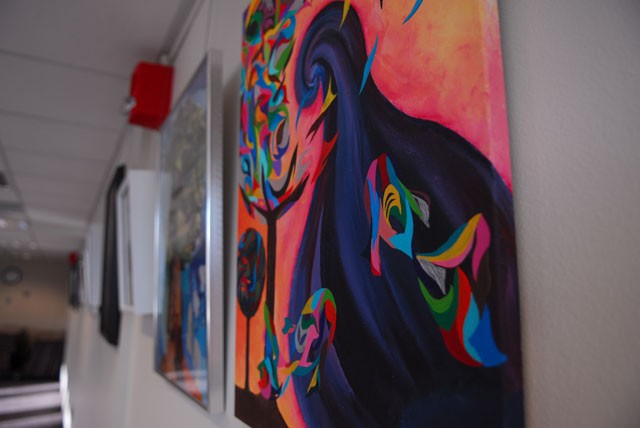Some patients with eating disorders are finding solace in an unlikely place: visual art.
âÄúArt gives them a nonverbal approach to communicate the difficulties that theyâÄôre struggling with,âÄù said Nicola Demonte, health educator and art therapist at Park Nicollet Melrose Institute.
As part of National Eating Disorders Awareness Week, Boynton Health Service will host a reception Wednesday for âÄúReflections: Healing Eating Disorders Through Art.âÄù
The exhibit, Demonte said, reflects âÄúwhat people are experiencing with eating disorders.âÄù
In all, it will include more than 20 pieces by anonymous Melrose Institute patients with eating disorders and a painting by a University of Minnesota student artist.
Architecture sophomore Beau SinchaiâÄôs painting was chosen from a pool of University students by a panel of representatives from Boynton, the Melrose Institute and University student group Active Minds.
Alice Johnson, senior coordinator of Active Minds, said she hopes the event will lessen the stigma associated with eating disorders and raise the discourse about mental health illness.
âÄúWe really want to connect students with the resources that are there on campus and have people be open enough to access them,âÄù Johnson said.
Jon Hallberg will host Hippocrates Café afterward, a combination of drama, literature and music to spark conversation and understanding of eating disorders, Boynton Mental Health Clinic Director Gary Christenson said.
Boynton Mental Health Clinic offers group therapy for students with eating disorders, in addition to eating disorder assessments and medical and nutritional consultations.
Boynton sometimes refers patients to the Melrose Institute or The Emily Program, both of which offer services specifically for those with eating disorders.
Demonte, who is the curator of the exhibit, engages his patients in art therapy, a hands-on process he developed there about two years ago, which he said has a positive physiological effect.
ItâÄôs common for eating disorder patients to say, âÄúI feel really relaxed right nowâÄù when they participate in art therapy, Demonte said.
Sinchai uses her artwork to fight stress too. She said she feels like many people donâÄôt realize the impact art can have.
âÄúI feel like art has been overlooked,âÄù Sinchai said.
Of 2,612 randomly surveyed students at the University, 4.8 percent of women and 0.5 percent of men reported being diagnosed with anorexia or bulimia in their lifetime, according to the 2010 College Student Health Survey, but that may not accurately represent the number of students with body image concern and eating disorder behavior.
âÄúWe suspect there are more students dealing with an eating disorder than reported on the survey,âÄù Christenson said.
He also said the diagnostic system may have âÄúset the threshold too highâÄù for anorexia or bulimia. The most common eating disorder, âÄúnot otherwise specified,âÄù he said, is diagnosed in students who fall short of one or two criteria for anorexia or bulimia.
âÄúThat doesnâÄôt mean they donâÄôt actually have an issue,âÄù Christenson said.
Demonte said studies show 4.5 to 18 percent of women and 0.4 percent of men have a history of bulimia by their first year in college , but many studentsâÄô eating disorder behavior, initiated by busy schedules, irregular eating habits and compulsory exercise issues, âÄúflies under the radar.âÄù

Art improves students’ mental health
Boynton is using an art exhibit to raise awareness of eating disorders.
by Jill Jensen
Published February 21, 2011
0

